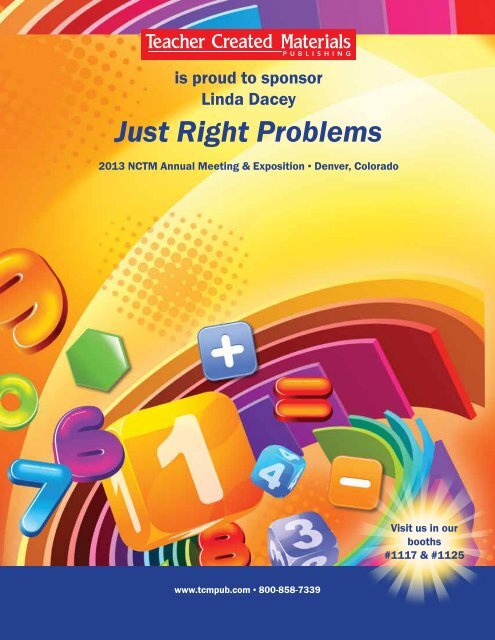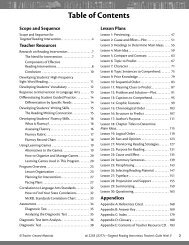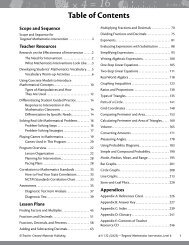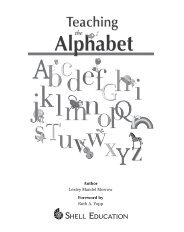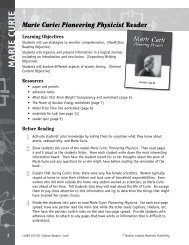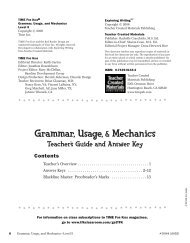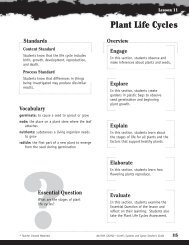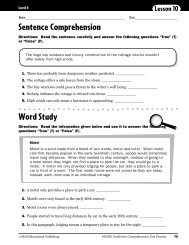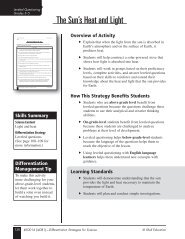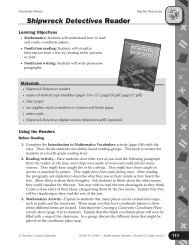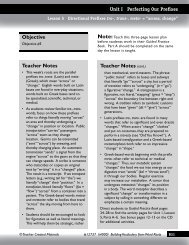Just Right Problems - Teacher Created Materials
Just Right Problems - Teacher Created Materials
Just Right Problems - Teacher Created Materials
Create successful ePaper yourself
Turn your PDF publications into a flip-book with our unique Google optimized e-Paper software.
is proud to sponsor<br />
Linda Dacey<br />
<strong>Just</strong> <strong>Right</strong> <strong>Problems</strong><br />
2013 NCTM Annual Meeting & Exposition • Denver, Colorado<br />
Visit us in our<br />
booths<br />
#1117 & #1125<br />
www.tcmpub.com • 800-858-7339
4/8/2013<br />
<strong>Teacher</strong> <strong>Created</strong> <strong>Materials</strong><br />
Dr. Linda Dacey<br />
Why We Need <strong>Just</strong> <strong>Right</strong> <strong>Problems</strong><br />
Students’ lack of success:<br />
The need to always have a “model”<br />
Achievement gap<br />
Non‐flexible thinkers who can’t apply<br />
their knowledge to new situations<br />
What We Need to Change<br />
Introductory problem and direct<br />
applications after practicing skill<br />
Isolated teaching of problem solving<br />
strategies<br />
Little or no differentiation<br />
Differentiation that leads to lack of<br />
debriefing<br />
Lack of progressive explicit instruction on<br />
how to justify thinking<br />
1
4/8/2013<br />
Standards for Mathematical Practices<br />
1. Make sense of problems and persevere in solving<br />
them.<br />
2. Reason abstractly and quantitatively.<br />
3. Construct viable arguments and critique the<br />
reasoning of others.<br />
4. Model with mathematics.<br />
5. Use appropriate tools strategically.<br />
6. Attend to precision.<br />
7. Look for and make use of structure.<br />
8. Look for and express regularity in repeated<br />
reasoning.<br />
#1 : Make sense and persevere<br />
Look for entry points<br />
Analyze givens, constraints,<br />
relationships, goals<br />
Think about a solution path<br />
Try special cases or simpler<br />
problems<br />
Understand the approaches<br />
of others<br />
<strong>Just</strong> <strong>Right</strong> or Leveled <strong>Problems</strong><br />
Allow for success for a range of learners,<br />
which motivates sense making and<br />
perseverance<br />
Provide a common setting and content<br />
for shared debriefing<br />
Give warm‐up opportunities<br />
Have expansion potential<br />
2
4/8/2013<br />
Ways to Level <strong>Problems</strong> and Tasks<br />
• Amount and types of scaffolding<br />
• Meaning and context<br />
• Complexity of the language<br />
• Way in which data are given<br />
• Number of solutions to be found<br />
• Number of conditions to be met<br />
• Sizes or types of numbers<br />
• Multiple intelligence or learning style<br />
What Do You Know About Colorado?<br />
1. Colorado borders _______ other states.<br />
2. It has an area of ______ square miles.<br />
3. It contains ______ of the land area of the<br />
U.S. with an altitude over 10,000 feet.<br />
4. In _____, Colorado became the _____th<br />
state to join the nation.<br />
5. It has _____ area codes.<br />
6. In 2012, the estimated population of<br />
Colorado was ______.<br />
Make sense<br />
Create viable<br />
arguments<br />
Context: Use Interesting Data<br />
About how many muscles does a caterpillar<br />
have in its head?<br />
The number is less than 1,000 + 200 + 10 +1.<br />
The number has a 2 in the hundreds place.<br />
The number is not equal to 3 x 90.<br />
Reason<br />
quantitatively<br />
3
4/8/2013<br />
Format: Use Puzzle‐like <strong>Problems</strong><br />
• Write the names and numbers<br />
to show who owns each cap.<br />
• Carla’s number is equal to<br />
5 + 9.<br />
• The sum of Will’s number and<br />
Mandy’s number is 12.<br />
• The sum of Mandy’s number<br />
and Pablo’s number is 11.<br />
Reason<br />
quantitatively<br />
How to Create Leveled <strong>Problems</strong>:<br />
Start in the Middle<br />
Manny has 7 coins.<br />
He has 40.<br />
He has no nickels.<br />
What coins does Manny have?<br />
Make sense<br />
Create viable<br />
arguments<br />
Be precise<br />
Simplify<br />
32<br />
4
4/8/2013<br />
Add More Challenge<br />
Janelle has 30.<br />
She has at least 1 penny, 1 nickel, and<br />
1 dime. What coins could she have?<br />
Find three possible answers.<br />
What Might You Do with this Problem?<br />
My bedroom floor is rectangular. One<br />
side has a length of 9 feet. The floor<br />
has an area of 108 square feet. What is<br />
the perimeter of my<br />
bedroom floor?<br />
Have Something to Talk About<br />
Jamie held _A_ animals at the pet store.<br />
She held mice, hamsters, and guinea pigs.<br />
She held _B_ more guinea pigs than mice.<br />
Jamie held _C_ guinea pigs and _D_ mice.<br />
Jamie also held _E_ hamsters.<br />
Look for<br />
and use<br />
structure<br />
5
4/8/2013<br />
Have Something to Talk About<br />
Which shape is different? Why?<br />
A different reason? A different shape?<br />
A B C D Make sense<br />
Look for and<br />
make use of<br />
structure<br />
Be precise<br />
What Do You Know?<br />
Oni Caitlyn Xavier<br />
Together Oni and Caitlyn have 22 nickels.<br />
Together Caitlyn and Xavier have 29 nickels.<br />
Caitlyn has one less nickel than Xavier.<br />
What is the value of the nickels in each bank?<br />
Make sense<br />
Reason<br />
quantitatively<br />
Give <strong>Problems</strong> Before Strategies Learned<br />
I have between 30 and 50 pennies. When I<br />
put them in piles of five, I have 1 penny<br />
left over. When I put them in groups of<br />
four, I have 1 penny left over. How many<br />
pennies do I have?<br />
Look for and<br />
make use of<br />
structure<br />
Look for<br />
repeated<br />
reasoning<br />
6
4/8/2013<br />
Encourage Alternative Strategies<br />
There are bicycles and tricycles for sale.<br />
There are 18 bikes for sale in all. There<br />
are a total of 51 wheels. How many of<br />
each type of bike are there?<br />
Try to find at least two ways to solve the<br />
problem.<br />
Look for and<br />
make use of<br />
structure<br />
Look for<br />
repeated<br />
reasoning<br />
Teach How to Explain Thinking<br />
• Clarify student thinking<br />
• Provide you access to student thinking<br />
• Create documentation<br />
• Support discourse<br />
Equation Frames<br />
To solve the problem, I first divided<br />
$13.60 by 16 to find the price per<br />
ounce. After that, I multiplied the unit<br />
rate of $0.85 by 6 to find the cost for 6<br />
ounces and found it was $5.10.<br />
Therefore, I know that 6 ounces of<br />
shampoo at that rate would cost $5.10.<br />
7
4/8/2013<br />
Procedural Language<br />
• What words: multiply to find…<br />
• Why words: since, because…<br />
• Transitional words: to start with, first, then,<br />
after that, second…<br />
• Concluding words: Therefore I know<br />
Word Walls<br />
• Include drawings, examples, and nonexamples.<br />
• Vary the arrangement<br />
• Include abbreviations and mathematical<br />
symbols.<br />
• Develop games and activities to use with the<br />
words that induce students to interact<br />
with the words.<br />
References<br />
Collins, Anne. 2012. 50 Leveled <strong>Problems</strong>, Grades 5<br />
and 6. Shell Education.<br />
Dacey, Linda. 2012. 50 Leveled <strong>Problems</strong>, Grades<br />
1, 2, 3, and 4. Shell Education.<br />
Dacey, Linda and Lisa Donovan. 2013. Strategies to<br />
y, g<br />
Integrate the Arts in Mathematics. Shell<br />
Education.<br />
Denman, Greg. 2013. Think It Show It<br />
Mathematics: Strategies for Exploring<br />
Thinking. Shell Education.<br />
8
50 Leveled Math <strong>Problems</strong><br />
Grades 1–6<br />
Operations and Algebraic Thinking<br />
Operations and Algebraic Thinking<br />
Boxes of Cupcakes<br />
Kwan bought 4 medium boxes of cupcakes for the birthday party.<br />
Standards<br />
• Understands strategies for the<br />
multiplication of whole numbers and<br />
their division<br />
• Knows that a variable is a letter or symbol<br />
that stands for one or more numbers<br />
Overview<br />
Within the context of buying boxes of<br />
cupcakes, these problems emphasize the<br />
array model of multiplication and division.<br />
Students write an equation to represent the<br />
problems and then solve them.<br />
Activate<br />
1. Display or distribute copies of the cupcake<br />
picture showing two boxes of cupcakes,<br />
one with a 2 × 1 array of cupcakes and<br />
one with a 3 × 3 array of cupcakes. Ask If<br />
you buy 3 packages of the small cupcakes,<br />
how many cupcakes do you buy? How did<br />
you find that answer? Did anyone find<br />
it a different way? What multiplication<br />
equation could we write to represent this<br />
situation?<br />
2. Continue to have students respond to<br />
questions about the cupcakes and to<br />
create equations to represent the different<br />
situations. Be sure to include questions<br />
that require students to find the number<br />
of groups, the number in each group,<br />
and the total number. For example, ask If<br />
you only buy large boxes and buy a total<br />
of 27 cupcakes, how many large boxes of<br />
cupcakes do you buy? Or say, You buy<br />
three boxes of cupcakes for a total of six<br />
cupcakes. How many cupcakes were in the<br />
boxes you bought?<br />
Problem-Solving Strategies<br />
• Count, compute, or write an equation<br />
• Organize information in a picture, list,<br />
table, graph, or diagram<br />
• Guess and check or estimate<br />
<strong>Materials</strong><br />
• Boxes of Cupcakes (page 39)<br />
• Cupcake Picture (cupcake.pdf)<br />
• Student Response Form (page 138)<br />
(optional)<br />
Solve<br />
1. Distribute copies of Boxes of Cupcakes.<br />
You may choose to have students work<br />
alone, in pairs, or in small groups.<br />
2. Observe students as they work. Are they<br />
counting by ones, skip counting, or using<br />
multiplication skills? Are they using fact<br />
strategies or do they retrieve a known fact?<br />
Debrief<br />
1. What did you get for an answer? How did<br />
you find it?<br />
2. Did anyone think about this differently?<br />
3. How do you decide what letter to use to<br />
stand for an unknown number?<br />
Differentiate ★ ● ■ ▲<br />
To help inform future instruction have<br />
students complete an exit card. Record 5 x 6<br />
for students and ask them to write about how<br />
they might find the product.<br />
Boxes of Cupcakes ▲ Boxes of Cupcakes ■ Boxes of Cupcakes ●<br />
Write an equation to show how many cupcakes<br />
Matt bought.<br />
Use a letter to stand for the number you need<br />
to find.<br />
How many cupcakes did Matt buy?<br />
Cassandra bought large boxes of cupcakes for the soccer party.<br />
She bought 40 cupcakes in all.<br />
Write an equation to show how many cupcakes<br />
Cassandra bought.<br />
Use a letter to stand for the number you need<br />
to find.<br />
How many large boxes of cupcakes did<br />
Cassandra buy?<br />
Jasmine bought some large boxes of cupcakes to give to friends.<br />
Dylan bought some small boxes of cupcakes to<br />
give to friends.<br />
They both bought the same number of boxes.<br />
Together, they bought 84 cupcakes.<br />
Write an equation to show how many boxes of<br />
cupcakes they each bought.<br />
How many boxes of cupcakes did each of<br />
them buy?<br />
Classroom Resources<br />
38 #50775—50 Leveled <strong>Problems</strong> for the Mathematics Classroom © Shell Education © Shell Education #50775—50 Leveled <strong>Problems</strong> for the Mathematics Classroom 39<br />
Research Based<br />
and Correlated to<br />
State Standards<br />
Level 3<br />
Developed in<br />
conjunction with<br />
Help students become more successful<br />
problem solvers!<br />
This series provides effective, research-based strategies to help teachers<br />
differentiate problem solving in the classroom and includes:<br />
◗◗<br />
◗◗<br />
◗◗<br />
◗◗<br />
◗◗<br />
50 math problems at 3 levels; 150 problems total.<br />
An overview of the problem-solving process.<br />
Ideas for formative assessment of students’ problem-solving abilities.<br />
50 mini-lessons and a student activity sheet with a problem tiered<br />
at three levels.<br />
Digital versions of activity sheets.<br />
Author Focus Linda Dacey<br />
Linda Dacey, Ed.D., is a professor of<br />
education and mathematics at Lesley<br />
University where she teaches courses for<br />
inservice and preservice teachers. A national<br />
and local leader, she is the co-author of<br />
numerous instructional materials designed<br />
to support the teaching and learning of<br />
mathematics. Dr. Dacey began her career<br />
in education as an elementary school<br />
teacher and still spends significant time in<br />
classrooms. Her current research focuses on<br />
ways to help teachers meet the needs of<br />
diverse students.<br />
Author Focus Anne M. Collins<br />
Anne M. Collins, Ph.D., is the Director of<br />
Mathematics Programs and the Director of<br />
Achievement Center for Mathematics at Lesley<br />
University. In her career she has taught at the<br />
elementary, secondary, and postsecondary<br />
levels. Dr. Collins has authored, edited, and<br />
reviewed numerous publications on mathematics<br />
instruction. Among her many leadership roles<br />
and honors, Dr. Collins is an elected member of<br />
the NCTM Board of Directors and was inducted<br />
into the Massachusetts Mathematics Educators<br />
Hall of Fame in 2005.<br />
Side A<br />
877.777.3450 | www.shelleducation.com<br />
B706 09/12
50 Leveled Math <strong>Problems</strong><br />
Grades 1–6<br />
50 Leveled Math <strong>Problems</strong><br />
8.5” x 11” • 144pp. • CD<br />
Authors: Linda Dacey and Anne M. Collins<br />
Level Item<br />
Level 1 50773<br />
Level 2 50774<br />
Level 3 50775<br />
Level 4 50776<br />
Level 5 50777<br />
Level 6 50778<br />
$15.99 each<br />
Related products to support<br />
50 Leveled Math <strong>Problems</strong>:<br />
<strong>Teacher</strong> <strong>Created</strong> <strong>Materials</strong><br />
◗◗<br />
◗◗<br />
Exploring Math<br />
Targeted Mathematics Intervention<br />
Shell Education<br />
◗◗<br />
◗◗<br />
◗◗<br />
Strategies for Teaching Mathematics<br />
Differentiation Strategies for Mathematics<br />
What’s Your Math Problem!?! Getting to<br />
the Heart of Teaching Problem Solving<br />
Side B<br />
877.777.3450 | www.shelleducation.com<br />
B706 09/12
Think It, Show It Mathematics<br />
Strategies for Explaining Thinking<br />
Grades 3–8<br />
Developed in<br />
conjunction with<br />
Two Step <strong>Problems</strong><br />
1 2<br />
Number Models<br />
1 __________________________________________________________________<br />
2 __________________________________________________________________<br />
Solution (label/unit)<br />
To<br />
• solve the problem<br />
• find the solution<br />
• answer the question<br />
I _______________________________________________________________<br />
________________________________________________________________<br />
________________________________________________________________<br />
and found _______________________________________________________.<br />
• Then • Next • After that,<br />
I _______________________________________________________________<br />
________________________________________________________________<br />
________________________________________________________________<br />
and found _______________________________________________________.<br />
Therefore I know __________________________________________________<br />
________________________________________________________________<br />
________________________________________________________________<br />
________________________________________________________________.<br />
Professional Resources<br />
Provides step-by-step strategies for<br />
developing students’ clear, concise<br />
writing and discussion skills about<br />
math problems.<br />
◗◗<br />
◗◗<br />
Strategy instruction is supported by student activity<br />
sheets, rubrics, and exemplar writing samples.<br />
Digital Resources include student activity pages<br />
Think It, Write It Mathematics:<br />
Strategies for Explaining Thinking<br />
Paperback • 8.5” x 11” • 176pp. • CD<br />
Author: Gregory A. Denman<br />
Pub Date: June 2013<br />
Category: Education/Teaching Aid<br />
Level ISBN Item Price<br />
Grades 3–8 9781425810511 51051 $39.99<br />
877.777.3450 | www.shelleducation.com<br />
B725 Think It Show It Math/Sci 02/13 p1/2
5301 Oceanus Drive<br />
Huntington Beach, CA 92649<br />
Name:<br />
Title:<br />
School Name:<br />
District Name:<br />
Address: (School or District? Circle one.)<br />
City: State: Zip:<br />
Email:<br />
How many students are in your district?<br />
Phone: Fax: How many students are at your site?<br />
Products I’m interested in:<br />
❏ Language Arts<br />
❏ Math<br />
❏ Elementary ❏ Middle ❏ High<br />
❏ Social Studies<br />
❏ Elementary ❏ Middle ❏ High<br />
❏ Science<br />
❏ Elementary ❏ Middle ❏ High<br />
❏ Other<br />
❏ Elementary ❏ Middle ❏ High<br />
❏ Technology Products<br />
❏ Elementary ❏ Middle ❏ High<br />
❏ Early Childhood<br />
❏ Professional Development<br />
& Resources<br />
❏ I would like a sales<br />
representative to call me.<br />
Best time to call<br />
_______________________<br />
Best way to contact<br />
_______________________<br />
Scan here to view<br />
our online catalog.<br />
AN76 09/11<br />
800-858-7339 ■ www.tcmpub.com<br />
■


